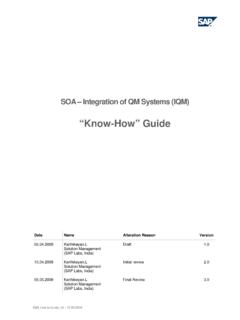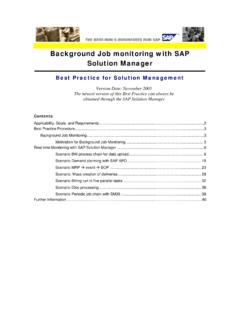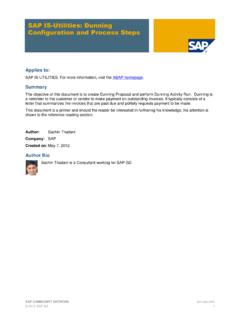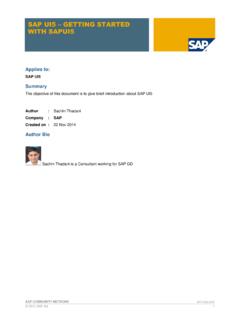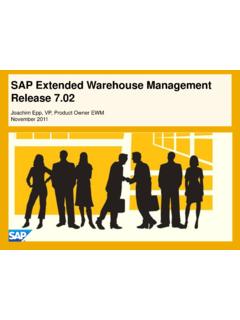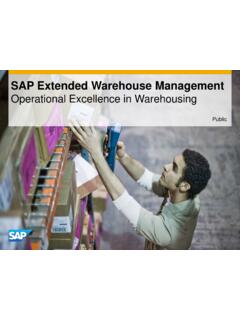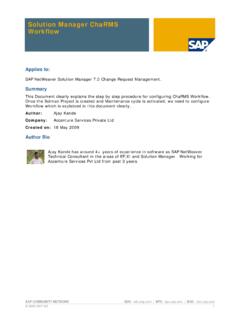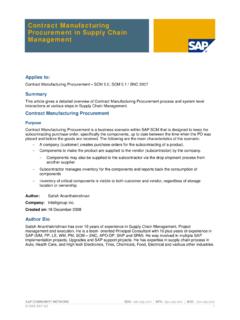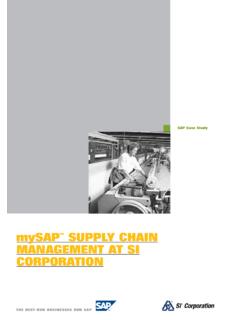Transcription of SAP with Oracle Real Application Clusters 11g …
1 SAP with Oracle real Application Clusters 11g Release 2 (RAC) on Microsoft Windows 2008 R2 An Oracle White Paper December 2011 SAP with Oracle real Application Clusters 11g Release 2 (RAC) on Microsoft Windows 2008 Release 2 SAP with Oracle real Application Clusters 11g Release 2 (RAC) on Microsoft Windows 2008 R2 Introduction .. 4 Naming Conventions and Terms .. 5 Installation and Migration Roadmaps .. 8 New Installation .. 9 Migrating from Oracle Single Instance .. 10 Migrating from Oracle RAC .. 11 Planning Oracle ASM Diskgroups .. 13 OCR and Voting .. 13 Oracle ACFS .. 14 Database Files .. 15 Prerequisites for running Oracle Grid Infrastructure 11g Release 2 and Oracle Database 11g Release 2 .. 18 Hardware.
2 18 Software .. 19 Common Setup and Installation Tasks .. 20 Preparing Microsoft Windows 2008 for Oracle Grid Infrastructure 20 Oracle Grid Infrastructure Installation .. 25 RDBMS Home Installation .. 37 Patching Oracle Grid Home and Oracle RDBMS Homes .. 39 RAC Enabling .. 40 SAP-specific database changes .. 47 Checking the Setup .. 47 Reusing Oracle ASM Disks .. 47 Working with Oracle ACFS .. 48 Checking Oracle 48 Backup and Restore .. 50 Configuring BR*Tools for Oracle ASM .. 50 Example init<sid>.sap files: .. 50 SAP with Oracle real Application Clusters 11g Release 2 (RAC) on Microsoft Windows 2008 R2 SAP Standalone Gateway .. 53 testing .. 54 Failures .. 54 Hardware Failures .. 54 Oracle Interconnect Failures.
3 54 Storage Failures .. 55 Software Failures .. 56 SAP Application Workload .. 56 Additional Performance Recommendations .. 57 4 Introduction Oracle real Application Clusters 11g Release 2 ( Oracle RAC) and Oracle Automatic Storage Management 11g Release 2 ( Oracle ASM) technologies provide unexcelled availability, scalability and performance for your SAP applications . This document guides you through the most important steps required, to install such a cluster and will also discuss the recommended path to migrate an Oracle Database 10g Release 2 based system (single instance and RAC) to Oracle RAC The pre-installation steps for setting up the underlying cluster hardware and the operating system are also discussed within this document.
4 However, due to the fact that hardware platforms are evolving quickly, the paper can just give some guidelines on what hardware is required and how it should be configured. In addition, as Oracle Global Naming Service (GNS) is recommended for bigger Clusters where nodes are dynamically joining and leaving, this kind of cluster configuration is not discussed in detail. Instead the paper focuses on cluster configurations running without GNS. On Microsoft Windows it may be impossible to integrate GNS into some customer s existing network environments as it requires a DHCP server and DNS server on the same network. While with Oracle 9i and Oracle the Oracle cluster Filesystem for Windows (OCFS) was the preferred way to share data among a number of cluster nodes OCFS is not supported anymore with SAP and Oracle RAC on the Windows platform.
5 Oracle ASM and Oracle ASM cluster Filesystem ( Oracle ACFS) is now the preferred and recommended storage platform and therefore installations with OCFS are not discussed here. Basic configuration steps on Oracle ASM will be described but more sophisticated Oracle ASM configurations like configurations with more than one storage system or storage based system copies are not covered within this document. These topics are discussed in another whitepaper ' SAP with Oracle real Application Clusters 11g Release 2 and Oracle Automatic Storage Management 11g Release 2 - Advanced Configurations & Techniques'. An additional, complementary whitepaper 'Moving your SAP database to Oracle Automatic Storage Management 11g Release 2 - A Best Practices Guide' is available on SAP Developer Network and on Oracle TechNet.
6 It discusses two different ways of moving an existing database from filesystem to Oracle ASM. SAP specific configuration hints and recommendations will be provided in this document as well as suggestions about basic test scenarios. 5 Finally the document will provide information about SAP specific configuration steps in order to properly run BR*Tools and database tasks scheduled from SAP Application servers. Naming Conventions and Terms Name or Synonym Description / Purpose Oracle ACFS Oracle ASM cluster File System is a cluster file system that uses Oracle ASM as the underlying volume manager infrastructure. Oracle ASM Oracle Automatic Storage Management is basically a volume manager for all Oracle Database related files and Oracle ACFS.
7 Oracle ASM Disk An Oracle ASM disk is usually a physical disk with a logical partition on it. On Windows the logical partition is created as an extended partition with a logical volume in it. Oracle ASM Disk Group A number of Oracle ASM disks form an Oracle ASM disk group. An Oracle ASM disk group has 1 or more 'failure groups'. An extended partition can span part of a disk or a whole disk. Logical volumes are created inside an extended partition. Failure Group A named group to which an Oracle ASM disk belongs to. Oracle ASM guarantees to never store the same data twice within a failure group. Redundancy is achieved by distributing the same data to multiple failure groups. OCR Oracle cluster Repository RMAN Oracle Recovery Manager 6 <DBNAME> Specifies the name of the database ( C11).
8 <DBNAME> is derived from the Oracle initialization parameter 'db_name'. If 'db_unique_name' is set then <DBNAME> is derived from 'db_unique_name'. <DBSID> Specifies the name of the database instance. For single instance databases <DBSID> usually equals <DBNAME> C11. with RAC the number of the instance is appended C111, C112, etc. In some examples below the abbreviation <DBSIDn> will be used where 'n' equals the number of the RAC instance. The environment variable ORACLE_SID is usually set to <DBSID> or <ASMSID>. This the depends on the environment of the OS user <SAPSID> Specifies the name of the SAP system id. It is used for OS user names c11adm as well as for authentication of the OS user with Oracle OPS$C11 ADM.
9 <IHRDBMS> RDBMS Software Installation Home. The shared installation Oracle Home directory where the Oracle RDBMS Software is installed. This is a shared directory on Oracle ACFS. <OHGRID> The local path of the Oracle Home where the Grid Software was installed. 'C:\ Oracle \GRID\11202', 'C:\ Oracle \GRID\11203', .. Note that for Grid Software Oracle Base it is required to use a local path outside of <OHGRID>. Therefore it is recommended to set Oracle Base to 'C:\ Oracle \BASE' during the Grid Software installation. 7 <OHRDBMS> RDBMS Runtime Oracle Home. The runtime path of the Oracle Home where the RDBMS Software was installed. On Microsoft Windows this is the same as <IHRDBMS>. 'C:\ Oracle \<DBNAME>\11202', 'C:\ Oracle \<DBNAME>\11203'.
10 SCAN The 'Single Client Access Name' is the name of a virtual host. In DNS the name should resolve to 3 different virtual IP addresses. NODE-IP The IP address of the node on the public network. The NODE-IP cannot failover and therefore identifies a physical cluster node. SCAN-VIP If SCAN was configured to resolve to 3 virtual IP addresses the SCAN-VIP is one of those. Please refer to on Oracle TechNet for further information about SCAN. NODE-VIP The virtual IP address of a cluster node on the public network. The NODE-VIP can switch from one node to another if the owning node fails or is taken offline. 8 OIC The ' Oracle cluster Interconnect'. This is the private network of the cluster . Installation and Migration Roadmaps This chapter outlines the recommended installation path for new installations and upgrade path for upgrades from older Oracle single instance or clustered environments to Oracle RAC with Oracle ASM.
